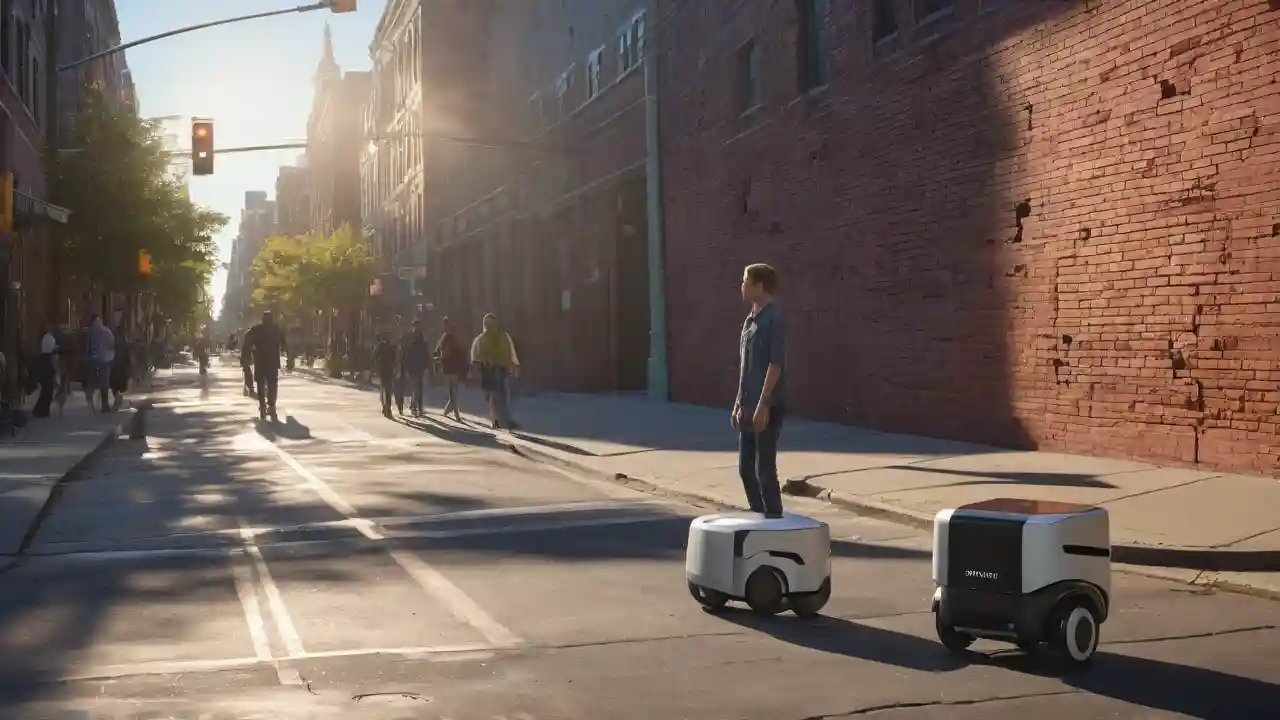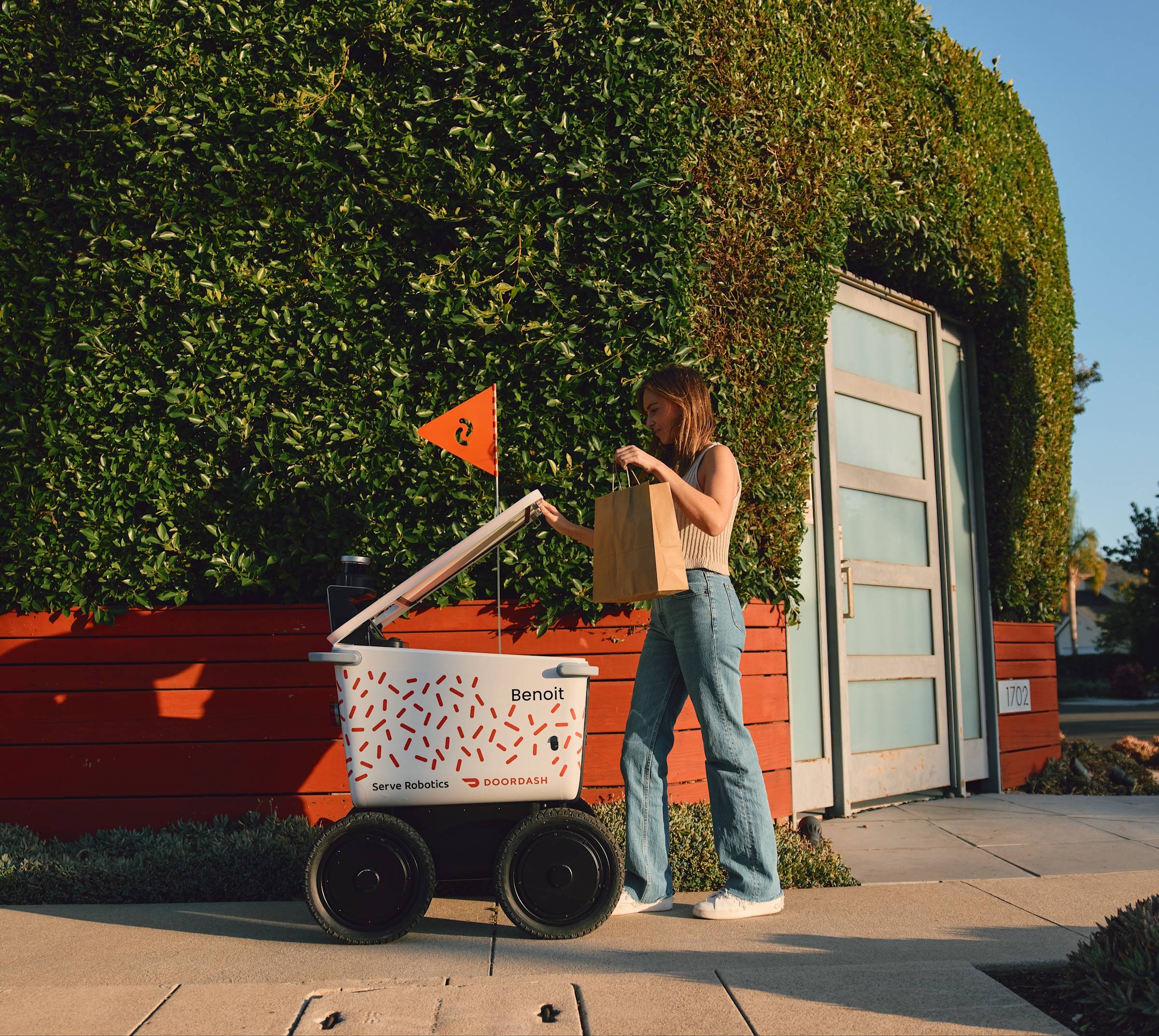
DoorDash Bets Big on Delivery Robots as Labor Costs Squeeze Industry
DoorDash Bets Big on Delivery Robots as Labor Costs Squeeze Industry
Food delivery leader signs multi-year deal with Serve Robotics, putting pressure on rivals to keep up—or risk losing ground
LOS ANGELES — DoorDash is leaning hard into the future of delivery. On Thursday, the company revealed a sweeping partnership with Serve Robotics, bringing fleets of self-driving sidewalk robots into American cities. It’s the clearest sign yet that DoorDash sees automation as essential for survival in a business where costs are climbing and margins are thin.
For now, DoorDash customers in Los Angeles will see Serve’s bots rolling out first. These little machines aren’t untested—Serve has already handled more than 100,000 deliveries from over 2,500 restaurants across cities like Miami, Dallas, Chicago, and Atlanta. More markets are in the pipeline, though local regulations will determine the speed of expansion. The timing is striking: just over a week ago, DoorDash also introduced Dot, its own in-house delivery robot, while maintaining a partnership with Coco, another robot operator active in LA and Chicago.
The big picture? DoorDash isn’t betting on one robot. It’s building a flexible delivery network that mixes humans, multiple robot vendors, drones, and its own hardware—choosing the cheapest and most reliable option for each order. Think of it like an air traffic control system for food, routing couriers and machines block by block, hour by hour. That’s a sharp break from early pilot programs, which typically tied one platform to one robot maker in small, controlled tests.

Why Robots Matter: The Cost Crunch
Labor has always been the biggest expense in food delivery. Paying human couriers for short trips—usually under two kilometers—can eat away profits fast, especially during slow hours when platforms shell out bonuses just to keep drivers on the road.
That’s where sidewalk robots fit in. Analysts say that in the right conditions—dense city blocks, smooth sidewalks, and limited human assistance—robots can cut delivery costs by 15 to 30 percent. But there’s a catch: every time a remote operator has to step in to guide a stuck bot, those savings shrink.
DoorDash’s multi-partner strategy reduces risk. By using Serve alongside Coco and Dot, the company can keep deliveries flowing even if one provider runs into technical issues or regulatory delays. Humans still play a role, especially for alcohol deliveries that require ID checks, tricky apartment drop-offs, or larger grocery runs. In effect, DoorDash is creating a tiered workforce, managed by algorithms that balance cost with complexity.
Local Laws Decide the Winners
Not every city welcomes robot couriers. Los Angeles has created a permitting system that allows them to operate commercially, setting it apart from nearby San Francisco, where robots remain confined to research zones with tight restrictions—like requiring a human minder within 30 feet.
This patchwork means the rollout won’t be national anytime soon. Instead, expansion will unfold city by city, shaped as much by politics as by technology. States like Texas and Florida, with friendlier rules and wider sidewalks, look like prime candidates for growth. Northeastern cities, with their crowded sidewalks and stricter accessibility enforcement, present tougher hurdles.
Serve Robotics has already proven it can scale, recently hitting the milestone of its 1,000th deployed robot. But growth isn’t just about hardware. To succeed, Serve must keep its robots busy, maintain charging hubs, and meet strict uptime targets set by partners like DoorDash.
A Platform War, Not a Hardware Race
DoorDash’s move mirrors Uber Eats, which has lined up its own roster of robot partners including Cartken, Nuro, and Avride across 11 cities. Both companies are chasing the same prize: controlling the “orchestration layer,” the smart system that decides whether a human, a robot, or even a drone makes the drop. That’s a very different play from earlier failures. Amazon pulled the plug on its Scout robot in 2022, while FedEx retired its Roxo program the same year—proof that simply owning robots doesn’t guarantee success in the chaotic world of sidewalk delivery.
One outlier is Starship Technologies. By focusing on college campuses and smaller towns with predictable environments, it’s managed more than eight million autonomous deliveries. That success highlights the potential—but also shows just how messy big-city streets can be in comparison.
The Roadblocks Ahead
Plenty of challenges could slow the robot march. Construction zones, blocked sidewalks, theft, vandalism, locked lobbies, or clashes with strollers and wheelchairs can all leave robots stranded, forcing humans to step in. Each of those incidents chips away at the savings.
Policy shifts loom large too. One accident—especially one tied to safety or accessibility—could prompt regulators to slam the brakes. Even Los Angeles’ supportive framework isn’t carved in stone; it could vanish with the wrong headline.
Then there’s vendor risk. DoorDash spreads its bets across multiple robot operators, but if several stumble financially at once, capacity could dry up. On the flip side, robot companies depend heavily on platforms for business, leaving them vulnerable to tough contract terms that squeeze profits.
And of course, customers and restaurants need to play along. Confusing hand-offs or a robot failing to locate a customer can sour the experience. Some restaurants may hesitate to deal with robots if the setup complicates their operations more than it helps.
What Investors Should Watch
For anyone tracking this shift, headline numbers won’t tell the full story. The real signals are in the details:
- How many short trips actually go to robots, broken down by city and time of day.
- Whether delivery costs on sub-two-kilometer orders really drop after automation.
- How quickly companies move from regulatory approval to real operations.
For the robot makers, the critical figures are fleet utilization, how often teleoperators intervene, and uptime reliability. Contract terms also matter: guaranteed order volumes give vendors stability, while pay-as-you-go deals leave them exposed if platforms pull back.
The Likely Future: Robots in Some Places, Not Everywhere
Looking ahead, most experts see robots handling 10 to 20 percent of eligible deliveries in a handful of U.S. cities over the next three years. That’s not a nationwide revolution, but in specific neighborhoods, it could reshape competition and margins.
The industry as a whole is forecast to grow more than 20 percent annually, fueled by better tech, looser regulations, and the rivalry between platforms. Still, those projections rest on shaky ground. A single regulatory setback could change the story overnight.
The strongest position belongs to platforms like DoorDash and Uber, which control demand and the orchestration systems. Hardware-focused startups face steeper odds unless they can prove reliability across multiple cities.
For consumers, the upside could mean faster, cheaper deliveries, especially on short trips. The downside? Robots stuck at locked gates, awkward hand-offs, and occasional accessibility headaches. In the end, the neighborhood you live in—and the city hall that governs it—will shape how much you see these machines.
DoorDash may now sit at the front of the delivery-robot pack, but the real test won’t be the tech itself. It’ll be whether the company can navigate a patchwork of local laws and deliver consistent savings at scale—obstacles that have tripped up even the biggest names before.
House Investment Thesis
| Category | Summary |
|---|---|
| Core Thesis (Author's View) | This is a maturing industry trend where platforms (DoorDash, Uber) are building a multi-vendor, multi-mode logistics strategy (humans, multiple bots, drones). This arbitrages unit economics and de-risks reliance on any single autonomy vendor. Adoption will be spiky, concentrated in policy-friendly cities (e.g., LA), following a city-by-city S-curve. The durable moat accrues to orchestration platforms, not hardware vendors, who will remain capacity providers. |
| Root Causes (Why Now) | 1. Unit-economics squeeze: Autonomy targets the least profitable, short-haul jobs to lift margins. 2. Supply optionality: Multiple autonomy partners balance capacity without over-incentivizing human couriers. 3. Regulatory aperture: Friendly frameworks like LA's enable scale, while restrictive ones (e.g., SF) limit it. 4. Vendor scale push: Vendors like Serve need volume from platform order books to boost utilization. |
| Trend Validation & Key Players | Short answer: Yes, it's a trend. Multiple players are converging on hybrid stacks. - Uber Eats: Mosaic of AV partners (Avride, Cartken, Coco, Nuro) across 11 cities. - Starship: 8M+ deliveries, scaling in campuses/small cities. - Coco & DoorDash: Live in LA & Chicago; Serve adds redundancy. - Counter-trend: Amazon/FedEx exits show ops + policy beat tech alone. |
| What's New in DoorDash × Serve | Brokered autonomy at scale: Serve is plugged into DoorDash's Autonomous Delivery Platform, letting the dispatch algorithm choose the cheapest mode per trip. This is a platform architecture shift with economic teeth. LA is the beachhead for a multi-year, multi-city expansion. |
| Economics & P&L Impact | - Cost Curve: Robots can cut all-in cost 15–30% for short-haul (1-2 km) jobs once utilization is stable. - Mix Shift: Platforms will route short, low-value baskets to robots, reserving humans for higher-margin, complex orders. - Capex/Opex: Vendors own robot capex; the platform P&L lever is variable cost deflation per trip. Vendors monetize via utilization and service fees. |
| Key Risks | - Ops Drag: Remote intervention minutes, theft, vandalism, and blocked paths erode margins. - Policy Shocks: Single incidents can trigger moratoria; city rules are a patchwork. - UX/NPS Variance: Issues with elevators, gates, and ADA compliance can cap opt-in, forcing human fallbacks. - Vendor Concentration: Vendor downtime or financing stress hurts platform reliability; vendors face platform take-rate pressure. |
| Investable KPIs to Watch | For Platforms (DoorDash/Uber): % of eligible orders routed to autonomy, cost per delivery for <2 km jobs, city expansion cadence, incident & intervention minutes. For Vendors (Serve/Starship/Coco): Fleet utilization hours/day, jobs per robot-day, tele-ops minutes per job trend, uptime, contract structure (minimums/offtakes), funding runway. |
| Competitive Positioning | - DoorDash: Edge in orchestration + demand; fastest to multi-mode broker (Dot, Coco, Serve, Wing). Risk: ops complexity. - Uber Eats: Edge in breadth + cross-vertical network; similar partner mosaic. Risk: herding partners to maintain SLA. - Starship: Edge in operational maturity in constrained domains (campuses). Risk: translating to big cities. - Amazon/FedEx: Their exits show distribution advantage ≠ sidewalk ops advantage. |
| Forward Scenarios (18-36 Months) | - Base Case: 10-20% robot share of eligible orders in 5-10 friendly U.S. metros; steady cost improvements. - Bull Case: Intervention costs fall; robot share hits 25-30% in select corridors; vendors secure offtake contracts. - Bear Case: A high-profile incident causes permit rollbacks; robot share stalls <10%; vendors face financing stress. |
| Investment Underwriting | - Treat autonomy as a margin call-option inside delivery platforms. - Favor orchestrators with scale data over single-hardware bets. - Demand city-level reporting; blended KPIs hide the story. - Scrutinize contract mechanics (minimum volumes, SLA penalties) between platforms and vendors. |
NOT INVESTMENT ADVICE